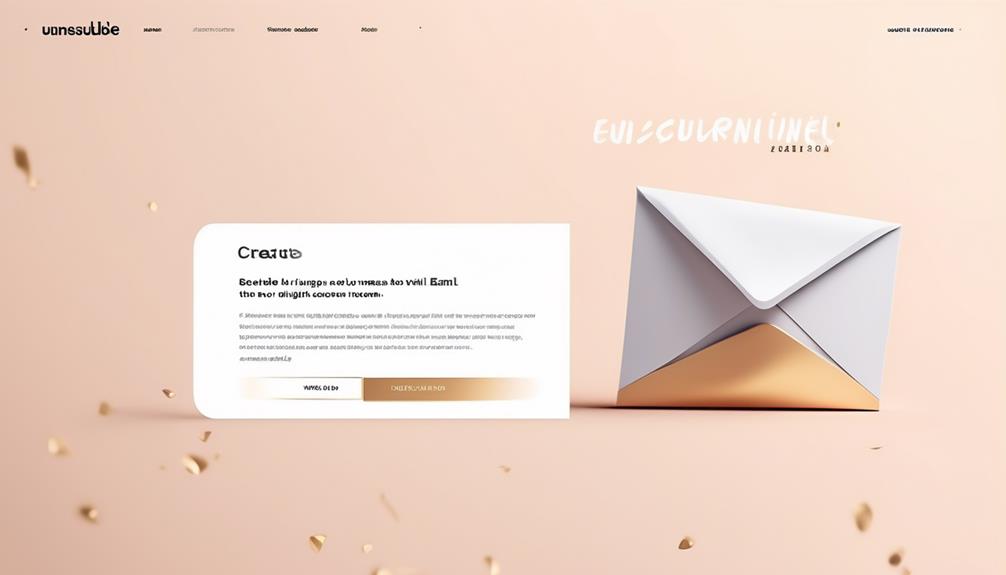Amidst the constant stream of online noise on our screens, **email** quietly stands its ground as a reliable form of communication, vying for our attention. The question remains: Is **email marketing** still impactful in the year 2024? Curious to find out? Keep reading to discover the answer.
As businesses navigate the ever-changing landscape of digital marketing, the effectiveness of email campaigns remains a topic of debate.
Join us as we explore the current state of email marketing, dissecting its relevance, impact, and potential future evolution, to uncover whether this age-old tool still holds sway in the modern era of marketing.
Key Takeaways
- Personalization and hyper-segmentation are crucial strategies for successful email marketing in 2024.
- Mobile optimization is paramount, as the majority of email interactions occur on mobile devices.
- Email marketing can showcase social responsibility by highlighting sustainable practices and supporting charitable initiatives.
- Ethical data collection and privacy laws are essential for maintaining trust and compliance in email marketing.
Email Marketing Trends in 2024
Email marketing trends in 2024 are rapidly evolving, with personalization and hyper-segmentation taking center stage as key strategies for engaging target audiences. According to email marketing statistics, personalized emails deliver six times higher transaction rates, highlighting the effectiveness of tailored content. Hyper-segmentation allows for precise targeting, ensuring that the right message reaches the right audience at the right time. This level of customization enhances customer experience and drives higher engagement.
Moreover, interactive and dynamic email content is gaining traction as it provides a more engaging and personalized experience for recipients. Incorporating elements such as quizzes, surveys, and image carousels creates a sense of interactivity, encouraging subscribers to spend more time with the email, thereby increasing the likelihood of conversions.
In addition, the integration of artificial intelligence (AI) into email automation and workflow automation streamlines processes and enhances personalization capabilities. AI enables predictive analytics, allowing marketers to anticipate customer behavior and tailor content accordingly.
Furthermore, email marketing is being integrated with other digital marketing channels to create a cohesive customer experience. This omnichannel approach ensures consistent messaging and a seamless customer journey, maximizing the impact of email marketing.
Despite the evolving digital landscape, email marketing still holds its position as one of the most cost-effective and direct ways to reach and engage target audiences.
Relevance of Email Marketing

As we move forward into the discussion of the relevance of email marketing, the evolution of personalized and hyper-segmented strategies sets the stage for understanding its enduring impact on engaging target audiences.
In 2024, the relevance of email marketing is undeniable, especially when considering its cost-effectiveness and direct line of communication with the audience. The ability to craft personalized communication through email marketing strategies not only enhances engagement but also yields higher ROI compared to other marketing channels.
It’s important to note that mobile optimization is paramount, given that the majority of email interactions occur on mobile devices. As a digital marketing agency, recognizing the significance of building quality email lists, implementing automation, and conducting regular campaign analyses is pivotal for email marketing success.
Looking ahead, the future of email marketing is promising, with a focus on even deeper personalization, integration of AI, and interactive content. These trends indicate the continued relevance and evolution of email marketing as a powerful tool for engaging and retaining audiences.
Therefore, in 2024, email marketing remains an indispensable aspect of a comprehensive digital marketing strategy.
Impact of Mobile Optimization
With the prevalence of mobile devices shaping user behavior, optimizing emails for mobile is a non-negotiable requirement for successful engagement in 2024.
The majority of email activity now comes from mobile devices, underscoring the critical need for mobile-friendly emails in email marketing campaigns. Failing to provide a seamless mobile experience may result in higher unsubscribe rates, emphasizing the importance of mobile optimization. Moreover, a significant portion of users delete emails that don’t display correctly on their phones, highlighting the necessity of mobile email optimization for retaining the audience.
To effectively engage with audiences and drive higher conversion rates, email marketers must prioritize mobile optimization to cater to the growing mobile user base. This means employing responsive design, concise and impactful content, and clear calls-to-action that are easily accessible on mobile devices.
Social Responsibility in Email Marketing

As we look ahead to the future of email marketing, it’s crucial to consider the ethical implications of data collection and the environmental impact of our campaigns.
By integrating social responsibility into our email content, we can showcase our commitment to important causes and engage customers on a deeper level.
Embracing sustainable practices and supporting charitable initiatives through our email campaigns not only aligns with ethical standards but also demonstrates our dedication to making a positive impact.
Ethical Data Collection
In the realm of email marketing, ethical data collection stands as a cornerstone of social responsibility, demanding explicit consent, transparency, and a commitment to safeguarding customer information.
When collecting data for email marketing, we prioritize ethical practices by:
- Obtaining explicit consent from individuals before adding them to email lists, respecting their privacy preferences in the digital landscape.
- Ensuring transparency about data usage and providing clear opt-out options, thereby prioritizing data privacy.
- Respecting customer preferences and frequency of communication, upholding social responsibility in email marketing.
By avoiding the purchase of email lists and unauthorized third-party data sources, and prioritizing data security, we uphold the principles of ethical data collection.
In 2024, ethical data collection remains essential for building trust and maintaining integrity in email marketing.
Environmental Impact
Harnessing the power of email marketing, we can drive impactful corporate social responsibility initiatives that champion environmental impact and sustainability efforts.
Email newsletters offer a unique platform to educate and engage users on social responsibility and environmental initiatives, providing in-depth content and storytelling opportunities.
With direct and personalized communication, companies can effectively showcase their commitment to environmental impact and sustainability, resonating with environmentally conscious audiences.
Leveraging email marketing allows for targeted messaging and tailored content, ensuring that environmental efforts and CSR initiatives are effectively highlighted.
Sales and Marketing Alignment

Maximizing sales and marketing alignment is crucial for driving business growth and enhancing the customer journey. To achieve this, we must:
- Align Strategies: By synchronizing sales and marketing strategies, we ensure that our efforts are complementary and cohesive. This alignment allows us to deliver consistent messaging and a unified brand experience, ultimately engaging our audience more effectively.
- Foster Collaboration: Creating an environment that encourages collaboration and open communication between sales and marketing teams is essential. When both teams work together seamlessly, they can leverage each other’s insights to better understand customer needs and behavior, leading to more targeted and impactful engagement strategies.
- Shared Metrics: Establishing shared key performance indicators (KPIs) and metrics between sales and marketing enables a unified focus on revenue generation and customer satisfaction. This alignment ensures that both teams are working towards the same end goals, driving business growth and maximizing the impact of our email marketing efforts.
Importance of Inbound Marketing

Embracing the power of inbound marketing is essential for businesses looking to cultivate strong customer relationships and drive sustainable growth through valuable, targeted content and experiences. Inbound marketing focuses on attracting, engaging, and delighting customers by providing relevant and helpful information. This approach helps build trust and credibility with the audience while addressing their needs and challenges. By creating and sharing tailored content, businesses can attract qualified prospects and nurture them into leads and customers. The emphasis on building long-term relationships and providing ongoing value to customers sets inbound marketing apart as a valuable strategy for sustainable business growth.
| Benefits of Inbound Marketing | Impact on Email Marketing |
|---|---|
| Attracts qualified prospects | Increases open rates |
| Builds trust and credibility | Enhances engagement |
| Nurtures leads into customers | Drives conversions |
| Provides ongoing value to customers | Strengthens customer loyalty |
Inbound marketing not only benefits overall business growth but also significantly impacts email marketing by increasing open rates, enhancing engagement, driving conversions, and strengthening customer loyalty. This interconnected relationship underscores the importance of incorporating inbound marketing strategies into the broader marketing approach.
Focus on Customer Service

As businesses, we know the importance of providing personalized communication to our customers. By prioritizing this approach, we can build trust and strengthen our relationships with our audience.
Implementing proactive customer service strategies won’t only improve satisfaction but also enhance customer retention and loyalty.
Personalized Communication
In today’s competitive market, personalized communication is a cornerstone of exceptional customer service, elevating the customer experience and nurturing lasting connections.
When it comes to email communication, personalization is paramount. It enhances engagement and response rates by tailoring emails to individual preferences and behaviors. Utilizing customer data to personalize content and offers can lead to higher conversion rates, making it a crucial aspect of current marketing trends.
Moreover, addressing customer inquiries and concerns promptly through personalized communication demonstrates attentiveness and care, further solidifying brand-consumer relationships.
Lastly, implementing personalized recommendations and exclusive offers based on customer behavior can drive loyalty and retention, showcasing the significant impact of personalized communication in fostering customer satisfaction and long-term brand advocacy.
Building Trust
With the foundation of personalized communication firmly established, we now turn our attention to the pivotal role of building trust through exceptional customer service.
Effective email marketing goes beyond visually appealing content; it hinges on the establishment of trust. By providing timely and helpful customer support, addressing issues, and inquiries, we build trust through reliable assistance.
Establishing transparent and clear communication channels ensures customers feel heard and valued, strengthening the relationship. Personalizing interactions and responses to cater to individual needs shows genuine care and understanding for customers, further enhancing trust.
Consistently delivering on promises and commitments demonstrates reliability and dependability in customer service. Prioritizing customer feedback and using it to improve the overall customer experience fosters trust and loyalty.
Ultimately, exceptional customer service is the cornerstone of building trust and reaping the benefits of effective email marketing.
Interactive Content Strategies

Utilizing interactive content strategies in email marketing can significantly enhance audience engagement and drive valuable user interaction. Incorporating interactive elements such as quizzes, polls, and calculators can involve the audience and provide a personalized experience.
Videos, GIFs, and animations not only make emails more engaging but also visually appealing, capturing the recipient’s attention. Interactive storytelling within emails creates immersive experiences, further increasing engagement and fostering a deeper connection with the brand or message.
Moreover, implementing interactive calls to action (CTAs) and feedback mechanisms encourages user participation and provides valuable insights into user preferences and behavior.
Incorporating gamification in email marketing presents an opportunity to enhance user engagement. By introducing game-like elements such as rewards, challenges, and competitions, brands can drive interaction with the content and increase the time spent engaging with the email. These strategies not only make emails more interactive and enjoyable but also provide valuable data for refining future email marketing efforts.
As digital marketing continues to evolve, leveraging interactive content in email marketing is essential for capturing and maintaining audience attention in an increasingly competitive landscape.
Privacy Laws and Customer Data

Transitioning from interactive content strategies, the landscape of email marketing in 2024 is intricately intertwined with privacy laws and the responsible handling of customer data, necessitating a strategic approach to compliance and transparency.
Privacy laws, such as GDPR and CCPA, impose stringent regulations on the collection, storage, and usage of personal data in email marketing. As custodians of customer data, businesses must prioritize obtaining explicit consent before adding individuals to their email lists. Moreover, they’re required to respect and adhere to customer preferences, ensuring that subscribers have the option to opt out or manage their data settings.
Transparency about data usage and protection measures is paramount for building trust and compliance with privacy laws. Email campaigns must align with these regulations, respecting the boundaries set by privacy laws and demonstrating a commitment to safeguarding customer information.
In 2024, the ethical and legal considerations surrounding customer data have become integral to the fabric of email marketing, shaping strategies and practices to ensure the responsible and compliant use of personal data.
Curated Content Techniques

We employ a diverse array of curated content techniques to meticulously select and present valuable information from a multitude of sources, ensuring a comprehensive and engaging resource for our audience. Our approach to curated content maximizes the impact of our email marketing strategies and enhances lead generation.
Here’s how we do it:
- Source Identification: We identify authoritative sources and analyze content quality to ensure that the curated material meets the highest standards of relevance and reliability.
- Tailored Content: Understanding the interests and needs of our target audience is paramount. By tailoring curated content to their preferences, we create a more personalized and engaging experience, driving better results in email marketing campaigns.
- Diverse Formats: We understand that diversity and appeal are crucial. Utilizing various formats such as blog posts, infographics, videos, and podcasts enriches the curated content, catering to different audience preferences and maximizing the impact of our lead generation efforts.
Automation and AI in Email Marketing

In the fast-paced world of email marketing, AI and automation are game-changers. These tools analyze customer data to send targeted and relevant messages, improving the efficiency and effectiveness of our campaigns.
AI in Email Marketing
With the integration of AI and automation, email marketing has undergone a revolution, enabling personalized content and hyper-segmentation for unparalleled engagement. AI in email marketing has become indispensable, as it allows for:
- Enhanced Personalization: AI tools analyze customer data to deliver highly personalized content, leading to improved open and click-through rates.
- Improved Efficiency: Automation streamlines various tasks such as scheduling, A/B testing, and analytics, optimizing the overall efficiency of email marketing campaigns.
- Dynamic Content: AI enables the creation of dynamic and interactive email content, fostering higher levels of engagement and responsiveness from recipients.
As AI continues to advance, its impact on email marketing remains profound, offering marketers the ability to deliver targeted, relevant, and timely messages that resonate with their audience.
Automation Benefits
Utilizing automation and AI in email marketing has revolutionized efficiency, personalization, and customer engagement, propelling campaigns to unprecedented levels of effectiveness.
Automation benefits in email marketing are vast. By streamlining repetitive tasks and workflows, it saves time and resources, allowing marketers to focus on strategy and creativity. AI-powered automation enables highly personalized and targeted communication, leading to better customer experiences and increased ROI.
Moreover, automated email campaigns can be triggered based on specific customer actions or behaviors, ensuring timely and relevant interactions. This level of precision and responsiveness strengthens customer relationships and drives conversions.
In the fast-paced world of digital marketing, automation isn’t just a convenience but a necessity for achieving and maintaining a competitive edge.
Personalized Content
Revolutionizing the way marketers engage with customers, personalized content powered by automation and AI is a game-changer in email marketing. Leveraging these technologies enables us to deliver tailored content that resonates with recipients, ultimately boosting engagement and conversion rates.
Here’s why personalized content through automation and AI is indispensable in email marketing:
- Increased Customer Engagement: Personalization fosters a deeper connection with recipients, leading to higher interaction levels and brand loyalty.
- Dynamic and Interactive Content: Automation and AI tools allow for the creation of compelling, real-time content that captures the attention of the audience.
- Timely and Relevant Communication: Utilizing AI enables us to deliver personalized messages at the right moment, enhancing the overall effectiveness of our email marketing campaigns.
In essence, personalized content driven by automation and AI is at the forefront of digital marketing, delivering impactful and targeted communication to our audience.
Evolution of Email Marketing

Email marketing has undergone a remarkable evolution, adapting to new technologies and consumer behaviors to remain a powerful tool for businesses. In the ever-changing landscape of digital marketing, email marketing has proven its resilience by offering stability, control, and affordability compared to other marketing channels. With a target audience of 4 billion daily email users, it provides a direct line of communication, making it a fundamental aspect of any marketing strategy.
The evolution of email marketing is evident in the emphasis on personalization and segmentation, which have significantly enhanced customer engagement and relationship building.
Moreover, the current trends in email marketing focus on mobile optimization, social responsibility, and inbound marketing. These elements are crucial in ensuring that email marketing remains effective in reaching and resonating with today’s consumers.
Looking ahead, the future of email marketing is poised to integrate advanced technologies such as AI, hyper-segmentation, dynamic content, and seamless integration with other marketing channels. This evolution reflects the adaptability and enduring relevance of email marketing in the fast-paced digital marketing landscape, making it an indispensable tool for businesses striving to engage and connect with their target audience.
Future of Email Marketing

With the relentless evolution of digital technologies and consumer behaviors, the trajectory of email marketing is poised for a dynamic transformation, integrating advanced tools and strategies to enhance engagement and resonance with target audiences. The future of email marketing holds exciting prospects, driven by innovative trends and technologies:
- Personalization and Hyper-Segmentation: Future email marketing will revolve around hyper-personalization, catering to individual preferences and behaviors. Advanced segmentation techniques will allow for highly targeted and relevant content, maximizing consumer engagement and conversion rates.
- Interactive and Dynamic Content: Interactive elements such as gamification and dynamic content will redefine email marketing, providing immersive experiences that captivate recipients. This will lead to increased interactivity and higher response rates, setting new benchmarks for customer engagement.
- Integration with AI and Automation: Leveraging artificial intelligence and automation will streamline workflows and enable unparalleled personalization at scale. AI-powered predictive analytics and automated email campaigns will revolutionize the efficiency and effectiveness of email marketing, shaping the future landscape of digital marketing strategies.
The future of email marketing is an amalgamation of cutting-edge technologies and consumer-centric strategies, promising unprecedented levels of customization and engagement in the digital marketing realm.
Is Email Marketing Still Effective in 2024?
Yes, email marketing’s effectiveness is still going strong in 2024. With personalized and targeted campaigns, businesses can continue to see high engagement and ROI from email marketing efforts. As long as marketers adapt to changing consumer behaviors and trends, email marketing will remain a valuable tool for reaching and connecting with audiences.
Frequently Asked Questions
Is There a Future for Email Marketing?
There is a bright future for email marketing. It allows us to engage with a large audience and offers measurable results with a high ROI.
Personalization and mobile optimization are key trends shaping its future. We must focus on building trust and complying with data privacy regulations.
Is Digital Marketing Still Relevant in 2024?
Digital marketing remains highly relevant in 2024. With the majority of consumer activity online, leveraging digital channels is crucial for reaching and engaging audiences.
It allows us to analyze data, target specific demographics, and adapt strategies in real-time. Our team believes in the power of digital marketing to drive results and connect with customers in a rapidly evolving landscape.
We continuously optimize our approach to ensure maximum impact and ROI.
What Is the Email Trend in 2024?
Personalization and hyper-segmentation drive 2024 email trends.
Interactive, dynamic content and AI-powered automation are prevalent, maximizing impact by integrating with other marketing channels.
Modern design and authentic communication foster stronger connections.
These trends are shaping the effectiveness of email marketing in 2024.
Is Email Marketing Still Effective?
Email marketing remains highly effective in 2024. We see significant engagement and conversion rates through personalized and segmented campaigns. Mobile optimization and compliance with data privacy regulations are crucial for success.
By building quality email lists, crafting compelling subject lines, and leveraging automation, we’ve seen enhanced efficiency and results.
Looking ahead, trends like AI integration and hyper-segmentation promise even greater effectiveness. Email marketing continues to be a key strategy for reaching and engaging audiences.
How Can Email Marketing Continue to Be Effective in 2024?
In the ever-changing landscape of digital marketing, email marketing effectiveness in 2024 will continue to be driven by personalization, automation, and engaging content. As technology evolves, marketers will need to adapt by utilizing AI and machine learning to deliver hyper-targeted campaigns that resonate with individual subscribers.
Conclusion
In conclusion, email marketing isn’t only surviving but thriving in 2024. With the right strategies in place, businesses can effectively reach their target audience, build relationships, and drive ROI.
As we look to the future, the evolution of email marketing will continue to shape the way we engage with subscribers. So, whether it’s through hyper-segmentation, interactive content, or AI integration, the future of email marketing is indeed bright.
Join us in shaping the future of digital communication.










